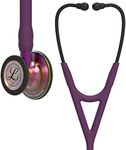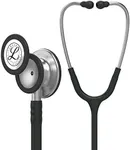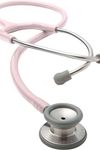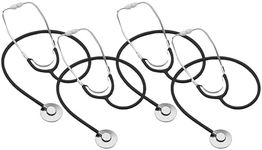Buying Guide for the Best Pediatric Stethoscope
Choosing the right pediatric stethoscope is crucial for healthcare professionals who work with children. A pediatric stethoscope is specifically designed to cater to the smaller body size and unique needs of infants and children. When selecting a pediatric stethoscope, it's important to consider several key specifications to ensure you get the best fit for your needs and provide the best care for your young patients.Chest PieceThe chest piece is the part of the stethoscope that is placed on the patient's body to listen to internal sounds. For pediatric stethoscopes, the chest piece is typically smaller to accommodate the smaller body size of children. This spec is important because a smaller chest piece can provide better contact and more accurate sound transmission. When choosing a chest piece, consider the age range of your patients. For infants, a very small chest piece is ideal, while for older children, a slightly larger one may be more appropriate.
Diaphragm and BellThe diaphragm and bell are the two sides of the chest piece. The diaphragm is used for high-frequency sounds, while the bell is used for low-frequency sounds. In pediatric stethoscopes, the diaphragm is often designed to be more sensitive to capture the subtle sounds of a child's heartbeat and breathing. The bell is usually smaller to fit the contours of a child's body. When selecting a stethoscope, ensure that both the diaphragm and bell are appropriately sized and sensitive enough to pick up the necessary sounds for accurate diagnosis.
Tubing LengthThe tubing length of a stethoscope affects both comfort and sound quality. For pediatric stethoscopes, shorter tubing is often preferred as it allows for better sound transmission and is easier to handle when examining small patients. However, the length should still be sufficient to allow comfortable use without straining. Typically, tubing lengths range from 22 to 27 inches. Choose a length that provides a balance between ease of use and sound clarity, considering your working environment and personal preference.
Acoustic PerformanceAcoustic performance refers to the stethoscope's ability to transmit sound from the patient's body to the healthcare professional's ears. High acoustic performance is crucial for accurately diagnosing and monitoring a child's health. Look for stethoscopes that offer clear and precise sound quality, with minimal interference. Some stethoscopes are specifically designed to enhance pediatric acoustic performance, so consider these options if you need to hear very subtle sounds.
Comfort and FitComfort and fit are important for both the healthcare professional and the patient. The earpieces should fit snugly and comfortably in your ears to ensure good sound isolation and prevent discomfort during prolonged use. Additionally, the chest piece should be comfortable for the child, with a non-chill rim to avoid causing distress. When choosing a stethoscope, try different models to find one that feels comfortable for you and is gentle on your young patients.
DurabilityDurability is an important consideration, especially in a busy healthcare setting. A durable stethoscope will withstand frequent use and cleaning. Look for stethoscopes made from high-quality materials that are resistant to wear and tear. Consider the warranty offered by the manufacturer as an indicator of the stethoscope's durability. A well-built stethoscope will provide reliable performance over time, making it a worthwhile investment.



















